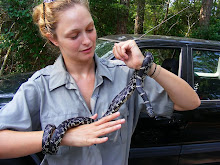Very early on in the course of my work here, I realized that the entire Sandhills Gamelands were littered with interesting and sometimes dangerous military castoffs. This is a direct result of sharing the Gamelands with Fort Bragg, which uses them to train soldiers in weapons and maneuvers. We are not supposed to interfere with military business, and they are not supposed to interfere with our scientific work. In fact, we are not supposed to establish contact of any kind, but it is still difficult to avoid occasional conflict, as, for instance, when the orienteering leaders take down my directional flagging, leaving me stranded in the middle of nowhere for unknown ages, with no idea where I might find my truck.
Last week I was out locating survey points for an upcoming study, and twenty soldiers came running over the hill in full camouflage with loaded automatic weapons. All I can really say to that is good for them. The main responsibility of my job is to be aware of the environment around me, and I had failed to notice twenty-one human beings (including the commander) until they had successfully captured my bird survey point. I did, however, manage to pick out a very rare Bachman’s sparrow nearby.
One notable example of interactions with the military and why not to have them occurred a month before I arrived. Three of our scientists were out on the Gamelands late in the evening to survey frogs, and were quickly surrounded by a large group of soldiers, who were there, announced their commander, to “deconflict the situation” (stress on the second syllable there). Did the frogs need deconflicting, or was it the scientists themselves? Or maybe, as was claimed, the “situation” itself needed deconflicting, but that’s a tough one to parse. I imagine that these interactions require both parties to peer through some veil of mystery, normally opaque to all of us, temporarily thinned in the mutual attempt to conceive that the other is doing something useful or relevant. All in all, I am not sure that that situation was ever deconflicted satisfactorily.
A rather more serious event occurred two years ago, when two soldiers in civilian clothes were taking part in reconnaissance training in one of the local towns. Because of lack of communication, the police sheriff was not informed of the exercise. He demanded to know what the soldiers were doing, and was treated by them a “plant,” as the real sheriff should have known about the exercise. With no other information to go on than that he was facing two hostile, armed youths, he shot them dead.
Some of the interactions with our non-civilian brethren are thankfully more passive in nature. On one of our regular trips through the Sandhills to delineate bird territories, I found an unopened MRE (Meal Ready to Eat) of “snack bread.” Curious as to its origin and edibility, I brought it along to lunch. The others were excited by the find, and assured me that there was a long and questionable history of eating every unopened military ration that the Sandhills offered. Kendrick and Ryan between them have found (stomach-cramp inducing) cheese tortellini with tomato sauce, jambalaya (tasty), drink mixes (ordinary), salt rations, and in the non-food category, long underwear, rain gear, unlit flares, live ammunition (common!), locking ammo boxes, and various personal effects, some of which are old, perhaps from the 1940’s. Institutional memory is strong among the field biologists here, transient though we may be, and the finds of field techs stretching back many years make for good conversation.
I imagine that there are many challenges in creating appetizing yet durable food, and said as much as I opened the sun-baked mylar pouch to share the contents with Kendrick. We both gave the flat, moist, shortbread-like confection high marks. It had an unmistakable but mild flavor of anise, and it made me want to find more of the same little pouches out on the Gamelands. But, I am told, you eat what you can find, and there have been no repeats thus far. Another day, another surprising lunch item.
Aside from the egregious amounts of litter, there are other reminders that we are sharing the Gamelands with the military. On languid afternoons when the sun is shining down through the pines and turning the grasslands into a gold ocean, the air is filled with primordial calls of flickers, and the constant singing of warblers, bluebirds, martins, finches and sparrows, but equally punctuated by an insistent RAT-TAT-TAT-TAT-TAT-TAT-TAT of machinegun fire, as well as the occasional, much larger explosion. Low-flying planes buzz over, four at a time, for what purpose I do not know. I pass lone soldiers orienteering through the Gamelands and realize again, each time I see them up close, that they are children, just over half my age, and this is all the preparation they will have before we send them off to war. My anger about the garbage I find everywhere gets deflated when I look at these people, as if I suddenly see that litter is only waste resulting from negligence, and not a much more serious waste caused by treachery and misinformation. These kids will be sent to Iraq and Afghanistan, and whether or not they return, and in what condition, is anyone’s guess. I sneak in a wave from time to time, and on rare occasions, they wave back.
Stay Deconflicted,
E
Wednesday, October 1, 2008
Life, The Army and You
Labels:
army,
Bachman's Sparrow,
biology,
birds,
conflict,
Fort Bragg,
frogs,
humor,
Iraq,
MRE,
MRE's,
north carolina,
orienteering,
soldiers
Subscribe to:
Post Comments (Atom)




No comments:
Post a Comment